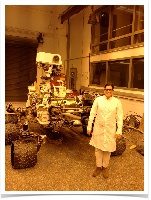Jen BlankFirst Officer (XO) Mission Specialist Planetary Sciences (MSP) Living in: Livermore, California (about 1 hour from NASA AMES and 50 miles from San Francisco) Special interest/s while on the mission:Astrobiology | |
Contact: | Jen Blank |
Profession: | Senior Research Scientist, contracting with NASA AMES Research Center
|
Professional qualification/s: | PhD Geochemistry (California Institute of Technology) MS Oceanography - Marine Geology (University of Washington) |
Passionate about Mars because:
Mars is the planet most like Earth in our solar system. I think Mars is the place that will be most hospital to human habitation one day.
We think that once Mars was warm and had water seas and oceans and may even have had life at the surface. Today, this is very unlikely to be the case. Even so, I think Mars is the other place in our solar system most likely to have life. Although I'd like to find little green men there, I think it more likely that there may be microbial communities living underground - where there is likely to be liquid water and where organisms would be protected from space radiation and the harsh conditions on the planet's surface.
Jen would like to live on Mars but only if she could bring her husband their pets with her.
Any other relevant detail/s:
At NASA Ames Research Center, I work in the field of Astrobiology. Astrobiology encompasses just about any subject you can imagine, but all of us who claim the title of Astrobiologist share an interest in the origin and evolution of life or life's building blocks and the conditions that once supported life or may support life in the universe. I study a Mars analog site in California a few hours away, focusing on the microbial ecology and carbonate minerals formed in spring waters; these minerals appear to be formed through biological activity and, as such, provide a record of life in the rocks long after they are gone. I also model chemical reactions that occur under the extreme conditions of cometary collisions with Earth; this shock of impact generates organic compounds that may have contributed to the origin of life. Finally, I'm a member of the Mars Science Laboratory science team, a group of over 400 scientists who are currently using the Curiosity rover to explore Gale Crater on Mars. Our goal as a team is to characterize the martian environment and look for evidence that Mars once was habitable to life. Within MSL, I'm affiliated with the ChemCam instrument that can probe the chemistry of materials up to 7m away from the rover by zapping them with a laser and collecting the light that's emitted from the target plasma. We're looking at the mineralogy of Gale and the textural features that indicate the presence of water in the past.
